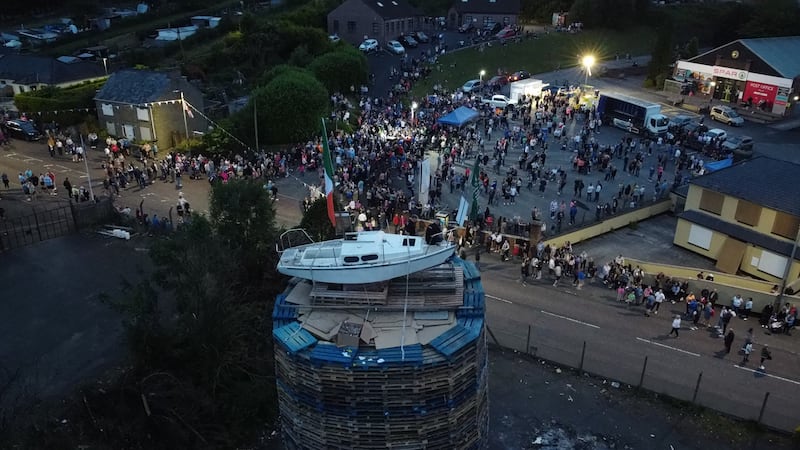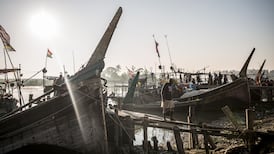Leo Varadkar’s picture may have appeared on a bonfire in Moygashel, Co Tyrone, but the real target of summer troublemaking is Jeffrey Donaldson.
The Taoiseach is entitled to feel differently, of course, while sympathy for the DUP leader must be limited.
Donaldson faces resistance from hardline unionists, some in his own party, over his obvious plan to restore devolution. The DUP will accept a legal assurance from London on the Windsor Framework, then change the subject to reform of Stormont’s budget.
This is all rather technical, given the passions involved, and time is running out. The framework comes into operation in October, when much of it will be exposed as unworkable. London and Brussels will then have to mitigate it via their repaired relationship – the true significance of the deal. If the DUP is not back in office by this point it will be a hostage to every problem the framework causes.
READ MORE
So Donaldson’s opponents smell weakness. However, keeping the focus on the sea border exposes their own weakness, as all their campaigns and protests against it have failed.
The marching season is a perfectly timed opportunity for distraction and destabilisation.
It is clear some people have considered how to exploit this to keep pressure on the DUP leadership. For others, frustration has broken out more spontaneously and with less thought of putting Donaldson on the spot.

In 2016, a deal was reached between Orange lodges and nationalist groups in North Belfast over the last big contentious parade in Northern Ireland, at Ardoyne.
This has delivered the longest period of peaceful summers since the 1950s.
Last month, a lodge in North Belfast applied for a parade that would have broken the deal. The application was endorsed by the Traditional Unionist Voice (TUV), the DUP’s hardline rival, which linked it to the installation of bilingual English and Irish street signs in Belfast.
“While one community’s culture is set to be imposed where it isn’t wanted 365 days a year, another community cannot celebrate theirs for a few minutes on a main road,” the TUV said. This threatened a whole new basis for parading disputes.
The Parades Commission rejected the application, citing “egregious disregard for... six years of peace”.
The DUP joined the TUV in condemning the rejection, but only through a comment from a councillor. The dispute then evaporated, amid general horror that anyone might unpick the 2016 deal.
An unsuccessful application was also made last month by Portadown’s Orange lodge for a 25th anniversary Drumcree parade.
The Drumcree dispute was never formally resolved. Instead, it has evolved into an annual token protest against the parade’s ban, acted out almost as a ritual. This was quietly repeated last Sunday – the Belfast Telegraph described it as “a mellowed affair”.
Portadown’s DUP MP, Carla Lockhart, was present. Two weeks ago, she tabled an early day motion in Westminster supporting the parade application.
Lockhart was widely condemned for attempting to reopen the Drumcree dispute. In reality, she was heading off any risk of the anniversary being used against the DUP.
Her early day motion, a parliamentary irrelevance, did not mention Irish street signs and bore the names of only four of the DUP’s eight MPs, all loyal to the leadership, yet not including Donaldson.
The Orange Order has no role in organising bonfires. Moygashel’s pile of pallets began making headlines last week when it was topped off with a boat and a “no Irish Sea border” banner. The community association responsible said this reflected “loyalist anger at breaking point” over the Windsor Framework and attacks on their culture. Loyalist activist Jamie Bryson gave an address before the fire was lit, demanding a continued boycott of Stormont. Donaldson and Bryson shared platforms during previous campaigns against the protocol.
The boat was an amusing stunt, reminiscent of satirical bonfire traditions elsewhere in the world. It would have been difficult to criticise had a tricolour and a picture of Varadkar not been added at the last moment. Their addition enabled Donaldson to issue a strong condemnation and make a broader call for compromise.
“I think the overwhelming majority of people want to see forward movement. We have got to resolve the issues which are at the heart of the current political situation,” he said.
The effigy of Michelle O’Neill that subsequently appeared on a bonfire in Dungannon, in an even more squalid display, was straightforward for the DUP leader to condemn.
Donaldson’s summer balancing act shows his ability to juggle on a tightrope, a skill not to be dismissed. The concern is how slowly he is inching the DUP forward, away from its Brexit mess. Orange intrigues and oblique criticism of Bryson are a long way from calling time on the circus.
There is little evidence that the DUP leader’s gifts of caution and patience are matched by decisiveness to bring his plans to a head. He may get unionism through a tricky marching season. Getting back to Stormont by September is another matter.














